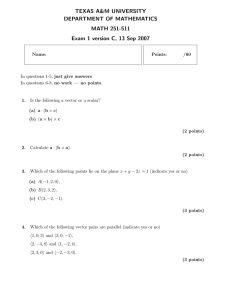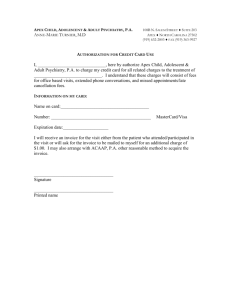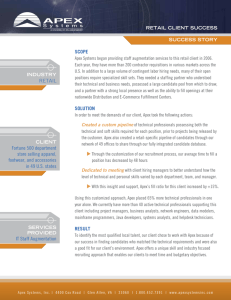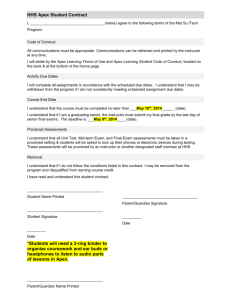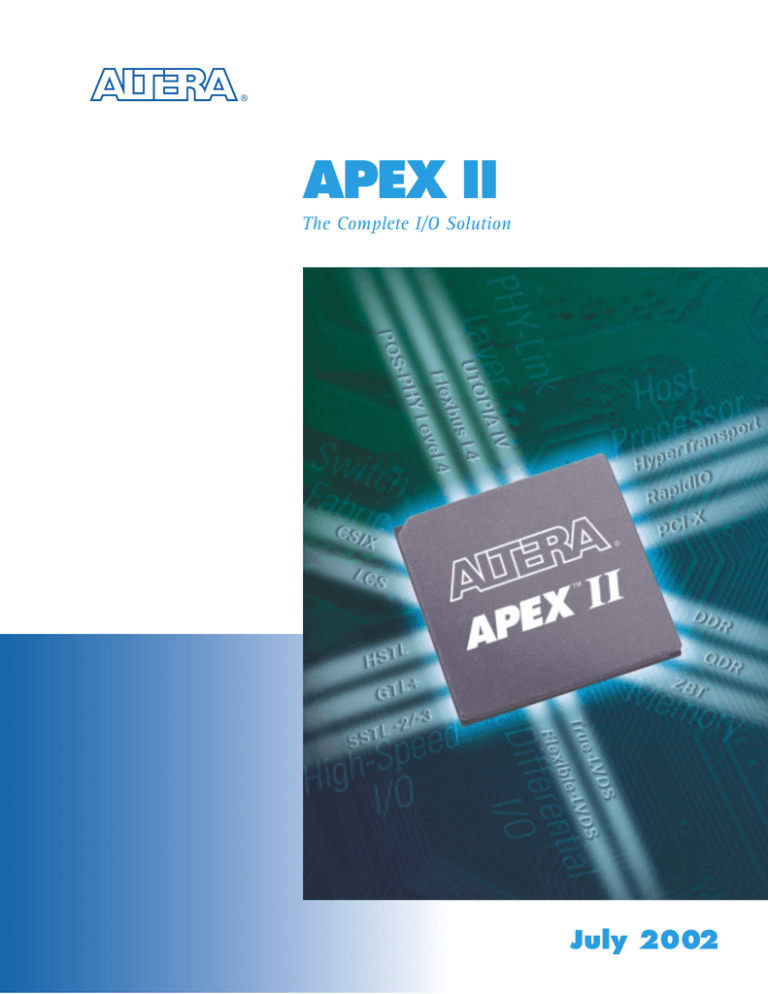
®
APEX II
The Complete I/O Solution
July 2002
Altera introduces the APEX™ II device family: highperformance, high-bandwidth programmable logic
devices (PLDs) targeted towards emerging network
communications applications and protocols. APEX II
devices support protocols such as the UTOPIA IV,
RapidIO™, CSIX, and POS-PHY Level 4 protocols,
making them the ideal solution for complex systems.
The APEX II device family features 1-gigabits per
second (Gbps) dedicated True-LVDS™ circuitry, phaselocked loops (PLLs), embedded system blocks (ESBs),
content-addressable memory (CAM), and enhanced
all-layer-copper interconnects.
Advanced High-Performance LVDS
■ 36 1-Gbps True-LVDS input and 36 1-Gbps True-LVDS
output channels
■ Up to 88 624-megabits per second (Mbps)
Flexible-LVDSTM input channels and 88 624-Mbps
Flexible-LVDS output channels
■ LVDS/LVPECL/PCML/HyperTransport™ I/O support
Supported I/O Protocols
Enhanced Architecture
■ RapidIO
■ 4 Kbits of memory per ESB
■ POS-PHY L4
■ Dual-port+ RAM in ESBs with
■ Flexbus
■ PCI-X
■ UTOPIA IV
■ CSIX
■ LCS
■ Zero-bus turnaround (ZBT),
double-data rate (DDR),
and quad-data rate (QDR)
memory interface support
bidirectional read/write ports
■ Eight PLL output taps
■ Six high-speed registers per
I/O element
The Complete I/O Solution
The high-density Altera® APEX II
device family offers advanced I/O
features to support a total systemon-a-programmable-chip (SOPC)
solution. APEX II FPGAs are based
on a 0.15-/0.13-µm all-layer-copper interconnect
technology to address the increasing performance and
bandwidth requirements of communication applications.
These devices offer versatility and flexibility for highperformance SOPC applications.
that can drive eight different global clock nets and/or
circuit signals for comprehensive clock management
and synthesis needs. On the following page, Table 1
describes some of the highlights of APEX II devices,
and Table 2 shows the wide range of features and
packages available.
I/O Standard Support for
High-Bandwidth Applications
The APEX II device densities range from 16,640 logic
elements (LEs) to 67,200 LEs. Based on state-of-the-art
SRAM process technology, the APEX II device family
supports a wide range of high-speed I/O standards such
as LVDS, PCML, LVPECL, HyperTransport, HSTL, and
SSTL, enabling high-speed I/O data transfers. With
True-LVDS circuitry, APEX II devices can achieve data
transfer rates of up to 1 Gbps per channel, and are
fully 64-bit, 66-MHz PCI and PCI-X compliant.
APEX II devices feature four general-purpose PLLs
APEX II devices have dedicated support for cutting-edge
I/O standards such as the HSTL, SSTL, LVPECL, PCML,
HyperTransport, CTT, GTL+, PCI-X, AGP, LVTTL, LVCMOS,
and LVDS standards—with performance up to 1 Gbps.
These I/O standards allow the APEX II device to
interface with other on-board devices in highbandwidth applications (as shown in Figure 1). APEX
II devices also feature the MultiVolt™ I/O interface,
allowing them to interface with devices using different
voltage levels, including 1.5 V, 1.8 V, 2.5 V, and 3.3 V.
Table 3 details the support APEX II devices offer for
advanced I/O standard applications.
Figure 1. APEX II Interface Support
True-LVDS Solution
Processor
■ 1 Gbps per channel
Host Processor Interface
■ RapidIO
■ HyperTransport
■ LVDS, LVPECL, PCML, and
■ PCI-X
HyperTransport I/O
■ 36 input and 36 output channels
PLD
Memory Interface
Clock-Data
Synchronization
Memory
■ ZBT, DDR, and QDR SRAM
■ Single-data rate (SDR) and
PLD
DDR SDRAM
Flexible-LVDS Solution
■ 624 Mbps per channel
■ LVDS, LVPECL and Hyper-
Transport I/O
■ 88 input and 88 output
channels
ASSP
PHY-Link Layer Interface
Switch Fabric Interface
■ UTOPIA L1, L2, L3, and L4
■ CSIX
■ POS-PHY L2, L3, and L4
■ LCS
■ Flexbus L3 and L4
Altera Corporation
3
Table 1. APEX II Highlights
Feature
Benefit
1-Gbps True-LVDS solution
Provides 36 input and 36 output high-speed channels for high-performance applications. Supports
LVDS, LVPECL, PCML, and HyperTransport
624-Mbps Flexible-LVDS solution
Up to 88 input and 88 output channels for high-bandwidth needs. Supports LVDS, LVPECL, and
HyperTransport standards
Clock-data synchronization (CDS)
Allows up to 36 independent data channels to interface with one APEX II device
Six registers per I/O element (IOE)
Provides support for high-speed external memory interfaces such as ZBT-, DDR-, and QDR-based
memory devices
Enhanced PLLs
Supports ClockLock™, ClockBoost™, and ClockShift™ circuitry for flexible clock synthesis and clock
management with eight output taps and two off-chip outputs
Advanced ESBs
Implements dual-port RAM with bidirectional read/write ports, first-in first-out (FIFO) buffers, ROM,
and CAM. 4 Kbits of memory per ESB
PCI and PCI-X compliance
Meets all specifications of 64-bit 66-MHz PCI and PCI-X
SignalTap® II logic analysis
Improves verification of chip functionality
Density up to 67,200 logic elements
Addresses system-level needs for a high-density device
MultiVolt I/O operation
Ideal for mixed voltage systems
FineLine BGA™ packaging
Area-optimized, 1.0-mm ball pitch provides high pin count
Vertical migration
Addresses changing device density without the need to re-spin the board
Table 2. APEX II Device Overview
Feature
Maximum system gates
EP2A15
EP2A25
EP2A40
EP2A70
1,900,000
2,750,000
3,000,000
5,250,000
Typical gates
600,000
900,000
1,500,000
3,000,000
Logic elements (LEs)
16,640
24,320
38,400
67,200
104
152
160
280
4
4
4
4
Maximum RAM bits
425,984
622,592
655,360
1,146,880
True-LVDS channels
(transmit/receive)
36/36
36/36
36/36
36/36
Flexible-LVDS channels
(transmit/receive)
56/56
56/56
88/88
88/88
Maximum user I/O pins
492
540
735
1,060
724-Pin BGA
672-Pin
FineLine BGA
724-Pin BGA and
672-Pin
FineLine BGA
724-Pin BGA
672- and 1,020-Pin
FineLine BGA
724-Pin BGA
1,508-Pin
FineLine BGA
ESBs
General-purpose PLLs
Available packages
Table 3. APEX II Protocol Support for Advanced I/O Applications
Application
RapidIO
HyperTransport
Data Bus Width (Bits)
I/O Standard
Device Throughput (Gbps)
8, 16
LVDS
32.0
2, 4, 8, 16
LVDS
51.2
CSIX
32
HSTL Class I
32.0
UTOPIA IV
32
LVDS
10.0
POS-PHY Level 4
16
LVDS
10.0
PCI
64
LVTTL
4.2
4
Altera Corporation
High-Performance Differential
I/O Support
APEX II devices support multiple high-speed differential
I/O standards including True-LVDS and Flexible-LVDS
solutions, LVPECL, PCML, and HyperTransport. Differential
signaling techniques facilitate high data transfer rates,
reduce electromagnetic interference, and simplify printed
circuit board design.
Flexible-LVDS Solution
The Flexible-LVDS feature uses ESBs for SERDES functions,
enabling data transfers of up to 624 Mbps in each
Flexible-LVDS channel. APEX II devices support up to
88 receiver and 88 transmitter channels. Flexible-LVDS
channels support LVDS, HyperTransport I/O, and
LVPECL inputs, and LVDS and HyperTransport outputs.
Clock-Data Synchronization
True-LVDS Solution
The True-LVDS solution uses dedicated circuitry to
perform high-speed data serialization/deserialization
(SERDES). Each True-LVDS channel supports data
transfer rates of up to 1 Gbps, as shown in Figure 2.
The APEX II devices feature up to 36 receiver channels
and 36 transmitter channels, as well as two independent
LVDS clock domains. Each channel supports LVPECL,
PCML, and HyperTransport as well as an independent
clock multiplication feature. True-LVDS clock-data
synchronization (CDS) can correct fixed multi-bit-period
skew between different LVDS receiver channels,
synchronizing them to a single clock input.
APEX II devices offers dedicated CDS circuitry to
compensate for fixed clock-to-data skew. CDS provides
designers the flexibility of synchronizing data from up
to 36 independent high-speed sources of varying trace
lengths and skews, as shown in Figure 3. Synchronizing
the clock and data channels on each high-speed
True-LVDS channel independently significantly
simplifies board design and helps designers fully utilize
the high-speed I/O capabilities of APEX II devices.
Figure 3. APEX II Clock-Data Synchronization
Enhances
Chip-to-Chip
Performance
Clock
Figure 2. 1-Gbps True-LVDS Solution in APEX II Devices
Data
Data
Clock
Data
Clock
Clock
High-Speed External Memory
Interfaces
The IOE in APEX II devices supports emerging highspeed memory interfaces such as ZBT, DDR and QDR
SRAMs, and SDR and DDR SDRAMs. Table 4 details the
APEX II support for external memory. Each IOE consists
of two input registers, two output registers, and two
output-enable registers that facilitate these advanced
memory access standards.
In addition to the APEX II IOE, Altera also provides
APEX II optimized intellectual property (IP) MegaCore®
functions to implement memory controllers that control
Altera Corporation
5
and CAM.
Table 4. External Memory Interface Support
Memory Type
SRAM
DRAM
Memory
I/O Standard
ZBT SRAM
LVTTL
DDR SRAM
HSTL
QDR SRAM
HSTL
SDR SDRAM*
LVTTL
DDR SDRAM
SSTL
*SDRAM is synchronous DRAM
the data access to and from external memory devices.
Please refer to the IP MegaStore™ site at
http://www.altera.com/IPmegastore for a list of available
controllers for different types of memory devices.
Breakthrough Performance with
All-Layer-Copper Interconnect
APEX II devices are built on state-of-the-art all-layercopper interconnect technology. Copper has lower
resistance and better electromigration characteristics
than aluminum. Copper interconnect delays are 70%
lower than aluminum, translating to core performance
improvements, and copper is more scalable than
aluminum, resulting in smaller die sizes.
Advanced Phase-Locked Loops
APEX II devices include four embedded generalpurpose PLLs with enhanced ClockLock, ClockBoost,
and ClockShift circuitry. These devices also feature
four dedicated LVDS PLLs for high-performance I/O
applications. ClockLock circuitry reduces clock delay
and skew within the device. ClockBoost circuitry
provides clock frequency multiplication and division,
minimizing the number of external clocks needed in
the design. ClockShift circuitry provides a programmable
clock delay and phase shift capability for aligning
clock edges.
Each PLL has two output taps with a maximum of
eight output taps per device that can independently
feed eight global clock lines internal to the device.
Each APEX II device also has two external clock
output pins fed directly from two separate PLLs.
Enhanced Embedded System Blocks
APEX II devices feature up to 270 ESBs for a total of
1.1 megabit (220 bits) (Mbits) of memory. Each ESB
accommodates 4 Kbits of memory that be configured
to various data widths: 256x16, 512x8, 1,024x4,
2,048x2, or 4,096x1 bits. The 4-Kbit ESBs can be split
into two 2-Kbit blocks, effectively doubling the
number of ESBs. APEX II ESBs support bidirectional
read and write ports based on two independent clocks,
synchronous or asynchronous RAM operation, and
high-speed first-in first-out (FIFO) buffers. The ESBs
can also be configured as high-performance CAM to
be used in high-speed search applications. Multiple
ESBs can be combined to create deeper, wider RAM
6
Altera Corporation
Quartus II Development Tool
& IP Simplify Design
The Altera Quartus™ II development
tool allows designers to process
multi-million gate designs. The
Quartus II software supports systemlevel solutions, integrates seamlessly with standard
revision control software, and allows designers to
implement advanced features such as LVDS, CAM, and
PLLs into their device designs. Using the Quartus II
software, designers can easily integrate complex IP
cores into their designs.
As shown in Table 5, the Quartus II software offers a
variety of features to aid the system designer, making
it the ideal platform for multi-million-gate designs.
Table 5. Quartus II Highlights
Feature
Benefit
LogicLock™ incremental
design capability
Allows for incremental optimization of a design
SignalTap embedded logic
analyzer
Reduces verification time by enabling designers to see
internal signal values while the system is running at speed
PowerFit™ fitting technology
Optimizes designs based on user's timing specifications and
meets design requirements with minimal user effort
NativeLink™ integration
Allows for seamless integration with third-party tools
Internet awareness
Provides up-to-the-minute information and file exchanges,
software updates, and support services through the Internet
Contact Altera Today
The APEX II device family provides the ideal solution
for your SOPC design needs. Visit the Altera web site
today to learn more about the APEX II device family and
its complete I/O solution at http://www.altera.com.
Altera Corporation
7
®
The Programmable Solutions Company ®
Altera Offices
Altera Corporation
101 Innovation Drive
San Jose, CA 95134
USA
Telephone: (408) 544-7000
http://www.altera.com
Altera European Headquarters
Holmers Farm Way
High Wycombe
Buckinghamshire
HP12 4XF
United Kingdom
Telephone: (44) 1 494 602 000
Altera Japan Ltd.
Shinjuku i-Land Tower 32F
5-1, Nishi-Shinjuku, 6-Chome
Shinjuku-ku, Tokyo 163-1332
Japan
Telephone: (81) 3 3340 9480
http://www.altera.com/japan
Altera International Ltd.
2102 Tower 6
The Gateway, Harbour City
9 Canton Road
Tsimshatsui Kowloon
Hong Kong
Telephone: (852) 2945 7000
Copyright © 2002 Altera Corporation. All rights reserved. Altera, The Programmable Solutions Company, the stylized Altera logo, specific device designations, and all other words and
logos that are identified as trademarks and/or service marks are, unless noted otherwise, the trademarks and service marks of Altera Corporation in the U.S. and other countries.
HyperTransport is a trademark of HyperTrabsport Consortium. RapidIO is a trademark of the RapidIO Trade Asspciation. All other product or service names are the property of their
respective holders. Altera products are protected under numerous U.S. and foreign patents and pending applications, mask work rights, and copyrights.
GB-APEX11-2.0




